|
|
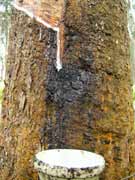
|
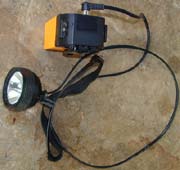 |
|
Rubber |
Rubber Reamer
|
 |
 |
|
Light for Harvesting Rubber
|
Rubber Frame
|
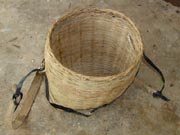 |

|
|
Rubber Crate
|
Rubber Tongue
|
|
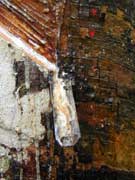
|
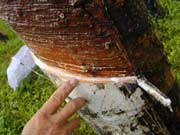 |
|
Rubber Knife and Sheath
|
Cutting Horizontal Lines
|
|

|
 |
|
Vertical Line, Cutting Surface, and Horizontal Line
|
Using Rubber Knife Sheath
|
|

|
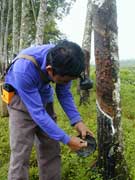
|
|
Cutting Rubber
|
Harvesting Rubber
|
In Xishuangbanna, the climate is quite warm from April to November; it rains frequently during this period, and the time is also the harvesting period for rubber. The weather is a bit cool from December to March of the next year. During this period, it is quite dry, and people will stop to harvest rubbers. In the harvesting season, at about 5 in early morning, the workers will walk into the rubber woods with a rubber light on the head and a rubber crate on the back. They will take with them a three-ridged knife for the cutting. At about 9 a.m., most of the workers will have completed their work, and they will leave the rubber tree milk flow down alone. At 11 a.m., the workers will begin to collect the rubber milk and will carry the milk back with rubber cans. Then, especially assigned people will use a rubber truck with cans to deliver the rubber milk into a rubber processing factory. If you have a careful look at the rubber woods, you will find that: the workers will cut an opening vertical to the ground surface and horizontal to the trees at a location about one meter high in the rubber trees; this is called the vertical line; then, they will use the vertical line as a base point, and cut a diagonal line upward or downward around the tree, which is about a half of the horizontal section of the tree; this is called the cutting line, and many cutting lines are called the cutting surface. In this way, the rubber milk will flow down along the cutting lines. There is a aluminum groove with a length of 10 cm and a width of 3 cm in the end of each cutting line, it is called the rubber tongue. There is a steel wire under the rubber tongue, which is twisted into the shape of "8". The "8" is big in one end, and small in the other. In the bigger end, there is an opening; in the smaller end, there is a small bowl. The steel wire is called the rubber frame, and the small bowl is often called the rubber cup. In this way, the rubber milk will flow into the rubber cup along the rubber tongue. Because rubber is quite sticky, so, at the time of harvesting the rubber, the workers often use a semi-round plastic chip to scrape the cup, in this way, they can collect all the rubber milk and thus cause no wastes. As a matter of fact, harvesting rubber is quite a technical work; at the time of cutting, the hands, eyes and feet of the workers must rapport with one another harmoniously; the hands must drive the knife in properly, the feet must follow in a timely manner, and the eyes must look at the cutting line carefully; besides, the cutting depth must be very accurate, if the cutting is too deep, it may harm the tree; if the cutting is too shallow, the rubber milk will not flow out. Experienced workers can master the depth by the margin of a hair. After the rubber is delivered to the processing plant, after filtration, congeal, hardening, roasting and grinding, the workers can get the primary rubber products.
In the recent years, tourism became more and more prosperous in Xishuangbanna. Rubber cutting performance also becomes an item of sightseeing. The skillful performances of the workers often win applaud from the audience. The seeds of rubber trees are as big as the thumb; their outer shells are hard and smooth; they are brown in color and are varied in grains. The local people often take them home and make them into various ornamental articles, and then sell them on the market. For hundreds of years, all the ethic groups of Xishuangbanna stay with the rain forests day and night; their clothes, foods, living and traveling all have close relations with the forests. They created brilliant ethical forest cultures, and their use of plants also reach the peak of perfection. They can make a very good musical equipment with tree leaves, which can produce very harmonious tunes. Though rubber trees are not original trees of Xishuangbanna, the leaves of rubber trees, because they are smooth, highly flexible, and beautiful, and have no poison, have become the first choice for artisans who make musical instruments with leaves.
It went without saying that the rubber woods with verdant leaves have become a landscape of Xishuangbanna; however, the rubber woods in the cutting-prohibited period, which will experience falling of leaves and growing out of new leaves, is perhaps the most beautiful landscape. After the cutting is stopped, verdant rubber woods will gradually change colors, they turn to red, yellow, or brown; looking from afar, the scenes are extremely beautiful. Some people even say that, the rubber leaves of Xishuangbanna can even vie with the maple leaves of Mount Xiangshan in Beijing. The more beautiful landscape is the rubber woods when the leaves start to fall; the leaves become less and less, and the smooth rubber branches gradually appear before our eyes. Taking a distant view at the rubber woods, you will feel they look like landscape paintings, which are quite poetic and artistic; some are like oil paintings, they have multiplied layers too. They are so beautiful that no one can describe them with words. They are really the masterpieces of nature.
Rubber trees, which experience thousands of cuttings, are also breeding the modern civilizations of human beings. They are making their contributions to the clothing, food, living and traveling industries of mankind selflessly.
|

